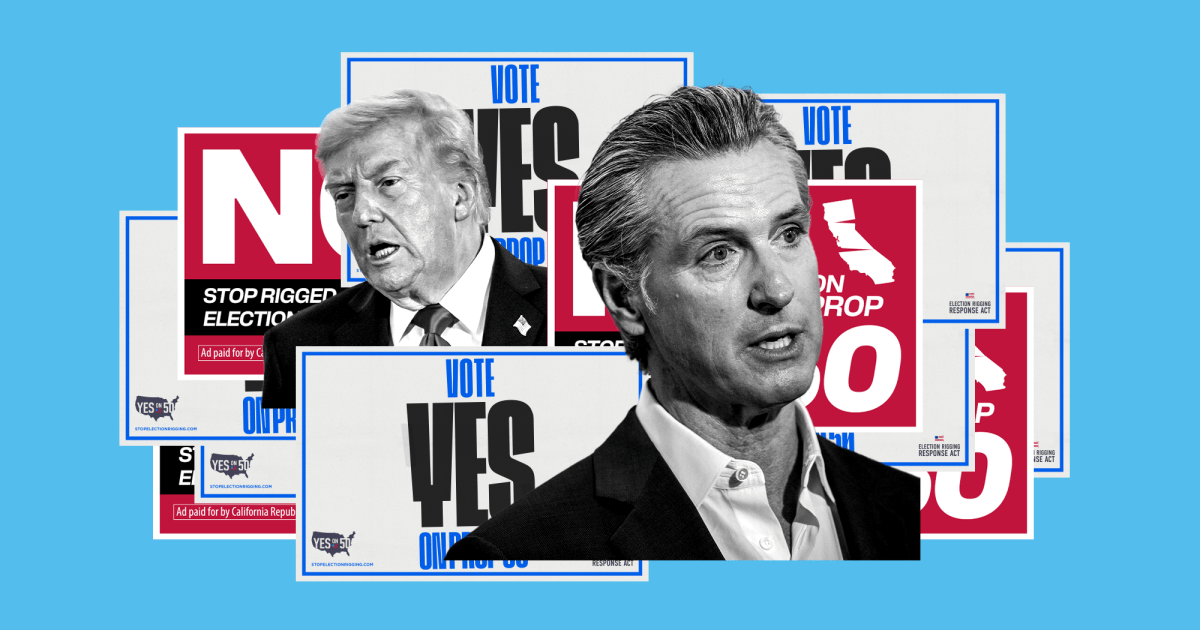If you live in California, like me, chances are you’ve been inundated with political ads and have a recycling bin filled up with mailers urging you to vote for or against Proposition 50, Gov. Gavin Newsom’s redistricting proposal in response to Texas’ newly gerrymandered congressional map.
Prop 50 is part of a larger redistricting fight unfolding across the country, as Democrats seek to retake the House of Representatives and Republicans try to retain their narrow majority in next year’s midterm elections. It all began in June, when President Donald Trump nudged Texas Republicans to redraw the state’s voting maps mid-decade, off the usual 10-year schedule, to swing five seats in the national party’s favor.
In response—and after the Texas GOP quashed Democratic opposition with threats of arrest—Newsom unveiled a proposal to counter Trump’s plans to rig the race.
“We have got to fight fire with fire,” Newsom said when announcing his plan to circumvent the state’s independent redistricting process and offset Texas’ gains with a map that would likely flip the same number of red seats blue. Since 2010, California’s congressional maps have been drawn by a nonpartisan 14-member commission of citizens. If Prop 50 were to pass, the state would adopt gerrymandered maps until the 2030 census, after which it would revert to the old model.
Since it was certified for the ballot in late August, Prop 50 has already become one of the most expensive ballot measures in California’s history, drawing about $140 million in spending for and against with weeks remaining until the November 4 special election.
More than twice as much—some $97.7 million—has gone to the Yes on 50 campaign. While tens of millions of dollars have been raised from small donors and labor unions, the largest contributions, about $11 million, came from the House Majority PAC, focused on electing Democrats to office, followed by $10 million from the Fund for Policy Reform, a lobbying group funded by billionaire Democratic donor George Soros.
Of the more than $42 million raised for the No campaign, the majority—$32 million—comes from conservative megadonor Charles Munger Jr., who helped former California Gov. Arnold Schwarzenegger establish the state’s nonpartisan Citizens Redistricting Commission in the late aughts and has donated to anti-abortion and anti-LGBT groups. The Congressional Leadership Fund, a Republican super PAC, and Republican former Speaker of the House Kevin McCarthy have also contributed $5 million and $1 million, respectively.
In one Munger-funded No on 50 ad with half a million views on YouTube, local politicians and faith leaders claim the measure will destroy California’s “reputation as a national leader for fair elections” and sacrifice “fair elections and voter choice.”
On the flip side, Yes on 50 ads featuring Gov. Newsom and California Sen. Alex Padilla, and well-known national Democrats including New York Rep. Alexandria Ocasio-Cortez, Massachusetts Sen. Elizabeth Warren, and most recently, former president Barack Obama, insist that the new map is needed to “protect democracy.”
As the 2026 midterms approach, ad spending is projected to reach a record $10.8 billion, with California leading at an estimated $1.1 billion.
In one ad, Texas Rep. Jasmine Crockett draws a straight line between her home and the Golden State, telling California voters, “When Donald Trump ordered Texas Republicans to rig the next election, they drew my seat off the map…With Prop 50, you have the power to stop them.”
As the 2026 midterms approach, ad spending is projected to reach a record $10.8 billion, with California leading the states at an estimated $1.1 billion in spending this cycle, according to an August report by AdImpact.
A Berkeley Institute of Governmental Studies (IGS) poll conducted in mid-August, before the ad blitz, surveyed nearly 5,000 registered voters—about 48 percent of whom said they would support Prop 50, with 32 percent against and the remaining 20 percent undecided.
“This will be an intense campaign with both sides spending tens of millions to try to move those undecided voters,” IGS co-director Eric Schickler predicted in a press release at the time.
A poll of nearly 1,000 likely voters conducted by the research company Co/efficient about a month later found that 54 percent of those polled supported the proposition, 36 percent opposed it, and only 10 percent were still undecided.
By comparison, campaigns around California’s most expensive ballot measures—Propositions 26 and 27, a 2022 pair of measures on legalizing sports betting, and Prop 22, a 2020 proposal about whether to recognize rideshare drivers as independent contractors or employees—received more than $463 and $224 million, respectively.
While efforts to pass those measures were bankrolled by major corporations with deep pockets, Prop 50 is unusual: it isn’t about the profits of one industry or a few firms, but who will hold the reins of federal government. While Texas’ new map faces challenges in federal court, and Californians wait to cast their ballots, the midterms—and Congress—hang in the balance.
Additional data analysis by Melissa Lewis.














